1. Animals Nervous System
- Books Name
- Iti Shree Science Book
- Publication
- Vaishnav Publication
- Course
- CBSE Class 10
- Subject
- Science
Chapter 7
Control and Coordination
Introduction
Different organs work together in an organism to carry out different functions, this is known as coordination. Proper control and coordination is necessary to carry out essential functions of the life.
Animal Nervous Tissue
- Animals’ nervous system consists of specialized nerve cells also known as neurons.
- A typical neuron consists of cell body, axon and dendrites.
- Cell body contains nucleus.
- Dendrites detects the information from the environment. This information is picked up by the dendritic tips and sets off the electrical impulse which travels from dendrite to cell body and then to axon.
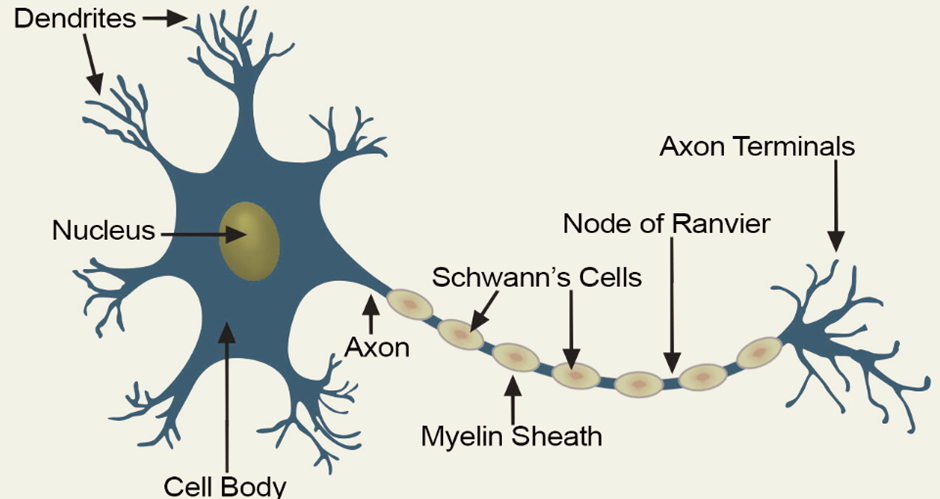
Structure of Neuron
Reflex Action
A sudden response to some environment stimulus is known as reflex. For example, we sudden take off our hand from the flame without thinking.
Reflex Arch
Sensory neurons synapse in the spinal cord before it passes to the brain. This pathway is known as reflex arch.
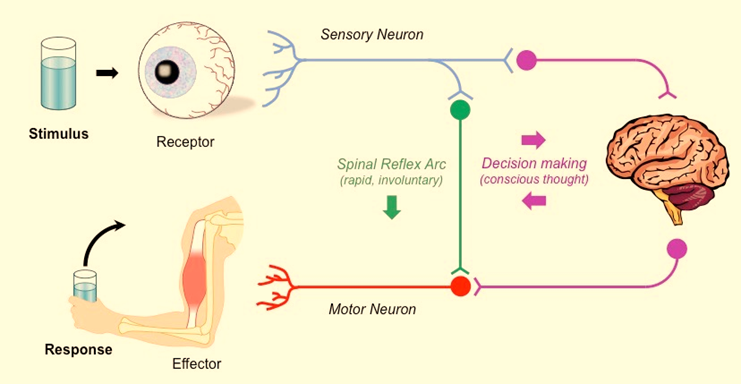
Reflex Arch
Human Brain
Brain is divided into forebrain, midbrain and hindbrain.
- Forebrain consists of cerebrum, hypothalamus and thalamus. Forebrain is specialized in hearing, sight, smell etc. It also controls voluntary movements in our body such as movement of leg muscles. Centre for hunger is also located in the separate part of forebrain. Cerebrum or the cerebral cortex consists of 4 lobes- parietal lobe, temporal lobe, occipital lobe and frontal lobes.
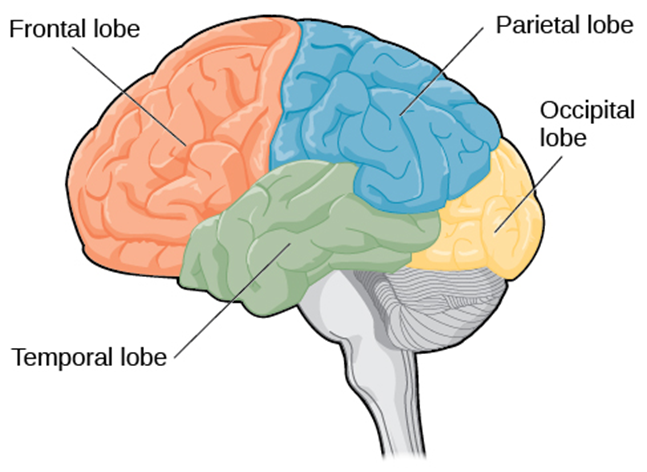
Different Lobes of the Brain
- Midbrain is located between the forebrain and hindbrain. It controls certain involuntary actions in the body.
- Hindbrain consists of pons, medulla and cerebellum. It controls salivation, blood pressure and vomiting. Cerebellum also controls certain important functions such as riding a bicycle, picking up a pencil. It also maintains posture and balance of the body.
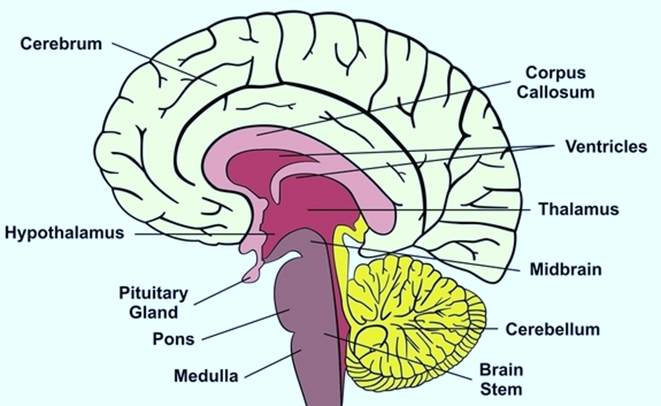
Structure of Human Brain
Brain is protected in a bony case known as cranium. Cranium also contains a fluid filled in it known as cerebrospinal fluid (CSF) that protects the brain from mechanical shock and injury. And spinal cord is protected by vertebral column.
How nervous tissue causes action?
Information is received by nervous tissue, then it passes to brain muscles and then it causes the action. The junction between the two neurons is known as synapse. Information are passed from one neuron to another neuron via electrical or chemical transmission.

2. Coordination in Plants
Basics Revisited
Equation
An equation is a statement that two mathematical expressions having one or more variables are equal.
Linear Equation
Equations in which the powers of all the variables involved are one are called linear equations. The degree of a linear equation is always one.
General form of a Linear Equation in Two Variables
The general form of a linear equation in two variables is ax + by + c = 0, where a and b cannot be zero simultaneously.
Representing linear equations for a word problem
To represent a word problem as a linear equation
- Identify unknown quantities and denote them by variables.
- Represent the relationships between quantities in a mathematical form, replacing the unknowns with variables.
Solution of a Linear Equation in 2 variables
The solution of a linear equation in two variables is a pair of values, one for x and the other for y, which makes the two sides of the equation equal.
Eg: If 2x+y=4, then (0,4) is one of its solutions as it satisfies the equation. A linear equation in two variables has infinitely many solutions.
Geometrical Representation of a Linear Equation
Geometrically, a linear equation in two variables can be represented as a straight line.
2x – y + 1 = 0
⇒ y = 2x + 1

Graph of y = 2
x
+1
Plotting a Straight Line
The graph of a linear equation in two variables is a straight line. We plot the straight line as follows:

Any additional points plotted in this manner will lie on the same line.
All about Lines
General form of a pair of linear equations in 2 variables
A pair of linear equations in two variables can be represented as follows

The coefficients of x and y cannot be zero simultaneously for an equation.
Nature of 2 straight lines in a plane
For a pair of straight lines on a plane, there are three possibilities
i) They intersect at exactly one point

pair of linear equations which intersect at a single point.
ii) They are parallel

pair of linear equations which are parallel.
iii) They are coincident

pair of linear equations which are coincident.
Graphical Solution
Representing pair of LE in 2 variables graphically
Graphically, a pair of linear equations in two variables can be represented by a pair of straight lines.
Graphical method of finding solution of a pair of Linear Equations
Graphical Method of finding the solution to a pair of linear equations is as follows:
- Plot both the equations (two straight lines)
- Find the point of intersection of the lines.
The point of intersection is the solution.
Comparing the ratios of coefficients of a Linear Equation

Algebraic Solution
Finding solution for consistent pair of Linear Equations
The solution of a pair of linear equations is of the form (x,y) which satisfies both the equations simultaneously. Solution for a consistent pair of linear equations can be found out using
i) Elimination method
ii) Substitution Method
iii) Cross-multiplication method
iv) Graphical method
Substitution Method of finding solution of a pair of Linear Equations
Substitution method:
y – 2x = 1
x + 2y = 12
(i) express one variable in terms of the other using one of the equations. In this case, y = 2x + 1.
(ii) substitute for this variable (y) in the second equation to get a linear equation in one variable, x. x + 2 × (2x + 1) = 12
⇒ 5 x + 2 = 12
(iii) Solve the linear equation in one variable to find the value of that variable.
5 x + 2 = 12
⇒ x = 2
(iv) Substitute this value in one of the equations to get the value of the other variable.
y = 2 × 2 + 1
⇒y = 5
So, (2,5) is the required solution of the pair of linear equations y – 2x = 1 and x + 2y = 12.
Elimination method of finding solution of a pair of Linear Equations
Elimination method
Consider x + 2y = 8 and 2x – 3y = 2
Step 1: Make the coefficients of any variable the same by multiplying the equations with constants. Multiplying the first equation by 2, we get,
2x + 4y = 16
Step 2: Add or subtract the equations to eliminate one variable, giving a single variable equation.
Subtract second equation from the previous equation
2x + 4y = 16
2x – 3y = 2
– + –
———————–
0(x) + 7y =14
Step 3: Solve for one variable and substitute this in any equation to get the other variable.
y = 2,
x = 8 – 2 y
⇒ x = 8 – 4
⇒ x = 4
(4, 2) is the solution.
2. Coordination in Plants
- Books Name
- Iti Shree Science Book
- Publication
- Vaishnav Publication
- Course
- CBSE Class 10
- Subject
- Science
Coordination in plants
Plants though do not have nervous system or muscles but they also respond towards the stimulus. For example, when we touch Mimosa pudica (touch-me-not plant), its leaves fold up and droop. There are two types of movements in plants -dependent on growth and independent of growth. When we touch the Mimosa pudica, its leaves fold up but no growth occurs, so it does not involve any growth. But movement of seedling is due to growth. Plants convey information from cell to cell through electrical-chemical means.
Hormone produced by plants

Movement due to Growth
The most common example of movement of growth are tendrils. Tendrils are sensitive to touch. When they come in contact with some object, the part of tendril away from the object will grow fast compare to the part of tendril which is in contact with the object. So it is a directional movement and it appears as if the plant is moving.
Directional movements of the plants are known as tropic movements. The movement can be towards the stimulus or away from the stimulus. Examples of some movements in plants are mentioned below-
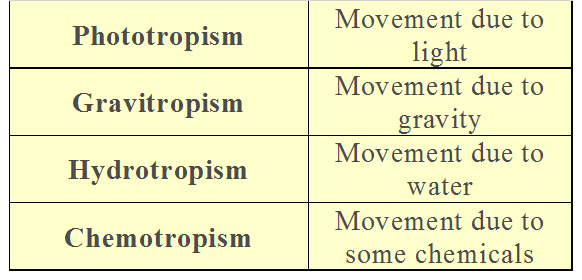
Many plant hormones are responsible for various kinds of movements in plants. Movements in plants can be divided into two main types:
1. Tropic movement
2. Nastic movement
1. Tropic Movement: The movements which are in a particular direction in relation to the stimulus are called tropic movements. Tropic movements happen as a result of growth of a plant part in a particular direction. There are four types of tropic movements.
(i) Geotropic movement: The growth in a plant part in response to the gravity is called geotropic movement. Roots usually show positive geotropic movement, i.e. they grow in the direction of the gravity. Stems usually show negative geotropic movement.
(ii) Phototropic Movement: The growth in a plant part in response to light is called phototropic movement. Stems usually show positive phototropic movement, while roots usually show negative phototropic movement. If a plant is kept in a container in which no sunlight reaches and a hole in the container allows some sunlight; the stem finally grows in the direction of the sunlight. This happens because of a higher rate of cell division in the part of stem which is away from the sunlight. As a result, the stem bends towards the light. The heightened rate of cell division is attained by increased secretion of the plant hormone auxin in the is away from sunlight.
(iii) Hydrotropic Movement: When roots grow in the soil, they usually grow towards the nearest source of water. This shows a positive hydrotropic movement.
(iv) Thigmotropism Movement: The growth in a plant part in response to touch is called thigmotropism movement. Such movements are seen in tendrils of climbers. The tendril grows in a way so as it can coil around a support. The differential rate of cell division in different parts of the tendril happens due to action of auxin.
2. Nastic Movement: The movement which do not depend on the direction from the stimulus acts are called nastic movement. For example, when someone touches the leaves of mimosa, the leaves droop. The drooping is independent of the direction from which the leaves are touched. Such movements usually happen because of changing water balance in the cells. When leaves of mimosa are touched, the cells in the leaves lose- water and become flaccid, resulting in drooping of leaves.
3. Animals Hormones
- Books Name
- Iti Shree Science Book
- Publication
- Vaishnav Publication
- Course
- CBSE Class 10
- Subject
- Science
Hormones
Hormones: These are the chemical messengers secreted in very small amounts by specialized tissues called ductless glands. They act on target tissues/organs usually away from their source. Endocrine System helps in control and coordination through chemical compounds called hormones.
Endocrine Glands
They are the chemical messengers that are secreted in small quantities. There are two types of glands-endocrine glands and exocrine glands. Endocrine glands do not have ducts to carry the secretion and they produces the hormones.
Exocrine glands do have ducts to carry their secretion. List of different hormones secreted, and their function are given below-
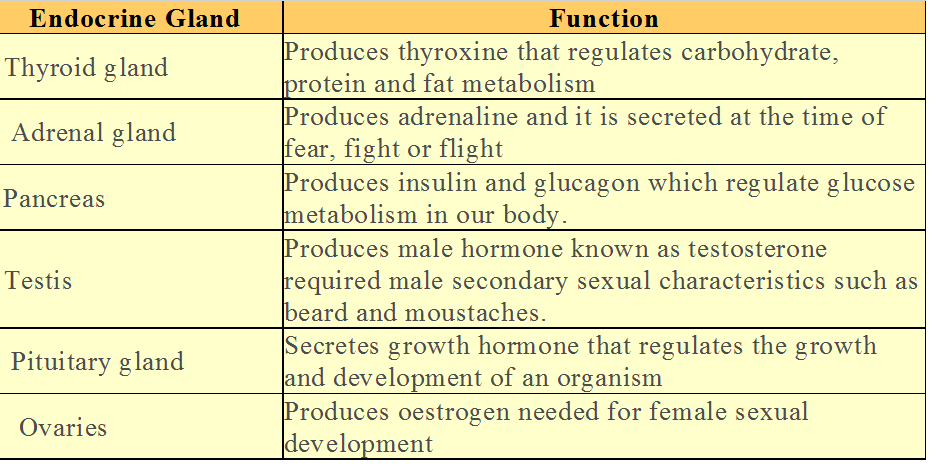

 Vaishnav Publication
Vaishnav Publication
